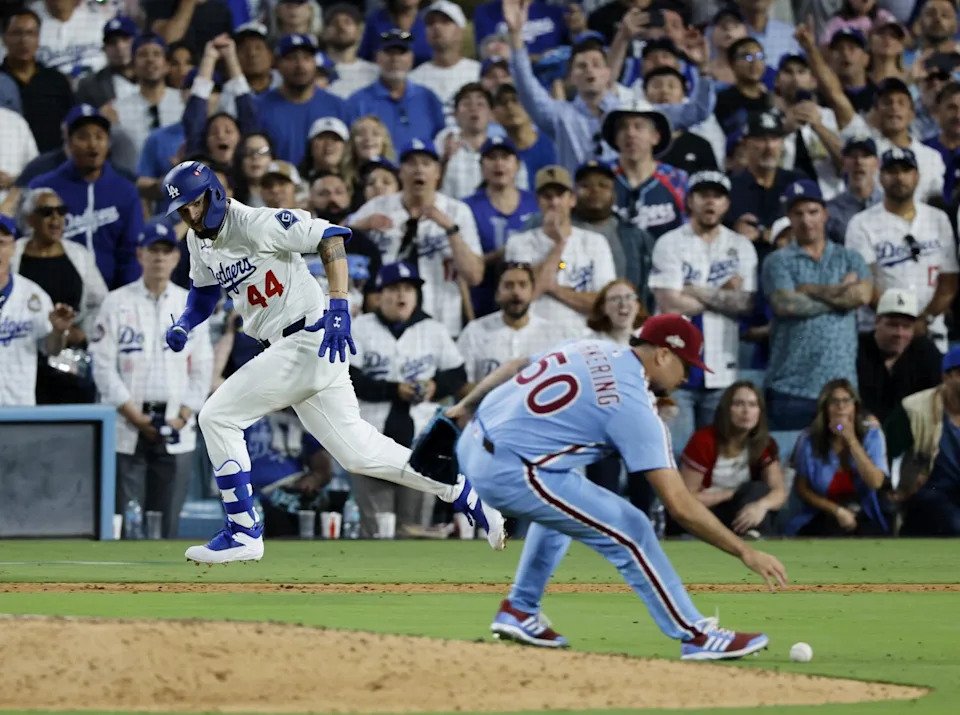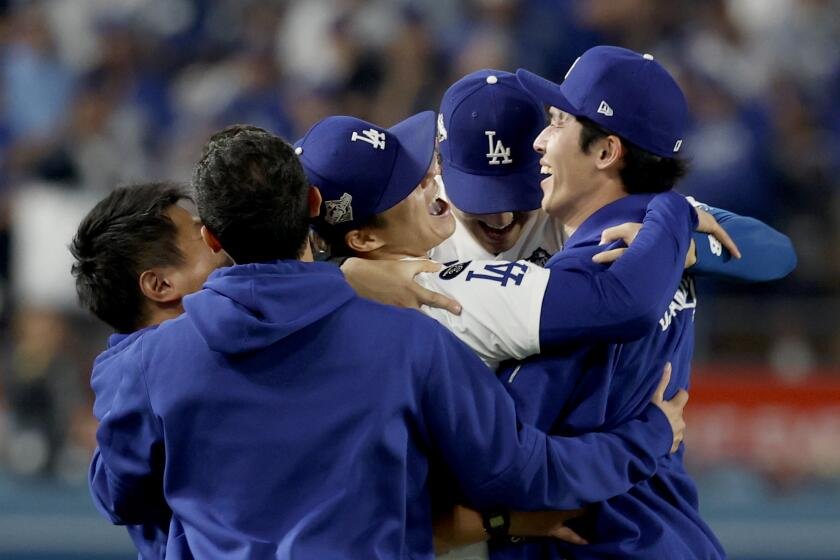They were going to win. They were going to lose. All in one breath, all in one month.
Win. Lose. Win. Lose. Win. Lose.
Win!!!
Weeks later the chest still pounds, the throat still thickens, the mind still has not completely grasped.
Advertisement
The Dodgers won their second consecutive World Series championship this fall in pure dramatic art.
Read more: Complete coverage: How the Dodgers won the 2025 World Series
A catch worthy of a statue. An out at home plate by history-making inches. A cheating outfielder steals a victory. A struggling first baseman steals a marathon. A sore-handed catcher steals a title.
The greatest postseason game by one player in baseball history. The greatest World Series by one pitcher in baseball history. The greatest moment by a Dodger benchwarmer in baseball history, a guy so embedded in the landscape of Los Angeles sports that he will be forever known simply by two abbreviated versions of his name…
Advertisement
Miggy Ro.
Enough said.
It’s perhaps appropriate today to give thanks for the drama, thanks for the art, thanks for the breathtaking uncertainty of the diamonds of October.
Thanks, baseball, for creating the tableau for the Dodgers’ 13 most memorable playoff moments, one for every win, one for every scream, one for every occasion when you thought it couldn’t get any crazier.
Then it did.
The Philadelphia Phillies’ Nick Castellanos is out at third after Dodgers shortstop Mookie Betts gets the throw from Max Muncy and applies the tag in the ninth inning of Game 2 of the NLDS at Citizens Bank Park. (Robert Gauthier/Los Angeles Times)
The Wheel
Who knew the Dodgers could so deftly field a bunt play? And who knew that this teamwork would strike the first big postseason blow against their most talented postseason opponent?
Division Series, Philadelphia Phillies, Game 2, ninth inning, the Dodgers lead 4-3 but there is a runner on second with none out.
Advertisement
A normally fielded bunt by Bryson Stott would have moved Nick Castellanos to third and put him in perfect position to tie the game. But the Dodgers ran the little-used “Wheel Play” in which third baseman Max Muncy fielded the bunt and spun and threw to Mookie Betts to tag Castellanos and save the game.
Betts suggested the play. Manager Dave Roberts signed off on the play. The Dodgers teamwork made the play work.
“We do a pretty good job of putting each other in good spots to be successful,” Betts said afterward.
The rest of the baseball world soon learn just how successful.

Dodgers outfielder Andy Pages watches as Philadelphia Phillies pitcher Orion Kerkering can’t field the ball cleanly in the 11th inning of Game 4 of the NLDS at Dodger Stadium. Hyeseong Kim scored on the play to win the game. (Gina Ferazzi / Los Angeles Times)
Orion’s Fallen Star
A year earlier, the Dodgers clinched the World Series on a night of New York Yankees meltdowns.
Advertisement
This autumn, the Dodgers clinched the division series on a night of a singular, stunning meltdown.
Dodger fans will forever see Phillies’ reliever Orion Kerkering botching Andy Pages’ grounder, panicking, then throwing wildly home to allow Hyeseong Kim to score the winning run in the 11th inning of Game 4, sending the Dodgers to the championship series.
It was the play that launched the three-sentence scream heard around town at various times for the rest of the nutty postseason…
“That’s it? We won? We won!”
‘Feeling Good’
The Dodgers cued up Shohei Ohtani’s walk-up song by Michael Bublé one afternoon in honor of his rarest of performances.
Advertisement
During the day off in the NLCS against the Milwaukee Brewers, Ohtani stunningly left the indoor cage and took on-field batting practice for one of the first times this season.
He was, at the time, two-for-his-last-25 with a dozen strikeouts. He was facing criticism that his pitching was affecting his hitting. The weight of the series was resting his giant shoulders.
He promptly put on a show, 14 of his 32 batting-practice swings resulting in home runs, including one that bounced off the right-field roof, a massive light show that contained a singular message.
“I got this.”
Dodgers designated hitter Shohei Ohtani hits one of his three home runs in Game 4 of the NLCS against the Milwaukee Brewers. (Robert Gauthier/Los Angeles Times)
He’s Got This
Two days after the momentous batting practice show, Ohtani did it for real, putting on a postseason pitching and hitting display for the ages, starting a wondrous debate that continues to this day.
Advertisement
What was more impressive?
His first-inning leadoff home run that followed three first-inning strikeouts?
His fourth-inning home after striking out the last two batters in the top of the inning?
Read more: Shohei Ohtani to participate in World Baseball Classic, but will the Dodgers star pitch?
His seventh-inning home run that came almost immediately after he was pulled from the game and should have been resting?
Since the fourth-inning blast soared over the right-field roof, um, er, I’ll go with that one.
And oh, his three-homer, 10-strikeout, six-plus innings performance sent the Dodgers to the World Series.
Advertisement
Where things really got interesting
Dodgers pitcher Clayton Kershaw stands on the mound during the 12th inning of Game 3 of the World Series. (Eric Thayer / Los Angeles Times)
The Farewell
It was eight pitches. It resulted in one out. It made barely a sound amid the fireworks that surrounded it.
But perhaps no single moment of the postseason was more enduring than Clayton Kershaw coming into World Series Game 3 against the Toronto Blue Jays with two out in the 12th inning and escaping a bases-loaded jam by inducing a ground ball by Nathan Lukes.
Because, it turns out, after 18 years, it was Kershaw’s last out as a Dodger.
And what if he had blown it? What if his legendary October demons had engulfed him one last time?
The way the crowd was so tensely silent during the Lukes at-bat, one got the feeling that everyone was thinking the same thing.
Advertisement
The collective sigh of relief was only overshadowed by the roar.
Dodgers first baseman Freddie Freeman reacts to his walk-off home run in the 18th inning in Game 3 of the World Series. (Gina Ferazzi/Los Angeles Times)
The Dance
It’s not fair that Freddie Freeman’s 18th-inning home run to end what equaled the longest World Series game will be somewhat forgotten in the wake of last year’s game-winning World Series grand slam.
But what I’ll remember most from this year’s heroics was the iconic celebration afterward, a dancing Ohtani skipping down to the bullpen with a dancing Roki Sasaki to engage in a group hug with a dancing Yoshinobu Yamamoto.
The three Japanese stars had truly found a home in Chavez Ravine, in each other, and in October.
The Dodgers had only a two-games-to-one lead in the World Series at the time, but was there any doubt their three Japanese stars would let them lose?
Advertisement
The Belly Flop
During the day off workout before the Dodgers would be faced with overcoming a three-game-to-two deficit in Toronto, Roberts issued the strangest challenge.
He claimed he could beat speedster Kim in a race around the bases.
The bet lasted barely 90 feet, as Roberts stumbled and face-planted just past second base, a pratfall which was captured on social media and celebrated by his laughing players.
His team loved the hell out of Roberts for doing it, and used the relaxed atmosphere to spark themselves to consecutive backs-to-the-wall victories.
“Of course it makes you smile and it makes you have a good time,” said Rojas.
Advertisement
Those good times were just beginning.
Dodgers second baseman Miguel Rojas gets the throw from Kiké Hernández, left, to double off the Toronto Blue Jays’ Addison Barger to end Game 6. (Robert Gauthier/Los Angeles Times)
Señor October
Whether it’s hitting three home runs in an NLCS clinching game against the Chicago Cubs in 2017 or hitting a homer in the NLDS clinching game against the San Diego Padres seven years later, Kiké Hernández has seemingly always been in the middle of the dynasty Dodgers’ success.
But never before had he stolen a game without his bat.
That’s what happened in the final breaths of Game 6 of the World Series when Hernández played against-all-orders shallow and picked off an Andrés Giménez line drive and threw to second to double off a straying Addison Barger and end the game with an intact 3-1 edge.
Advertisement
A role player during the regular season, Hernández had once again saved them when it mattered most.
Remember that catch and throw when you don’t see him again until next October.
The Dodgers’ Miguel Rojas reacts while rounding the bases after his solo home run tied the score in the ninth inning of Game 7. (Gina Ferazzi/Los Angeles Times)
Miggy Ro
This requires only one sentence, because it’s already been ingrained deep in your soul.
Two outs from elimination in Game 7, on a full-count pitch from Toronto closer Jeff Hoffman in the ninth inning, Miguel Rojas tied the score by hitting his only his second home run since the All-Star break.
Miggy Ro forever.
Oh, Yeah, Wait, One More
In the bottom of the ninth in Game 7, playing second base with the infield in, Rojas cleanly fielded a grounder and threw out Isiah Kiner-Falefa by inches at home plate to save the game.
Advertisement
Kiner-Falefa has since taken plenty of grief for not taking a bigger lead from third that would have allowed him to beat the throw, but the bottom line is, Rojas made the great catch and throw and Will Smith made the great play and the Blue Jays were simply doomed.
Miggy Ro forever… again.
Center fielder Andy Pages reaches to catch a fly ball hit by Blue Jays’ Ernie Clement for the out as he collides with Kiké Hernández, left, to end the ninth inning of Game 7. (Robert Gauthier/Los Angeles Times)
The Statue
If the Dodgers were to hire a sculptor to encapsulate their 2025 playoff run, the artist would undoubtedly bronze a replica of Andy Pages leaping over Hernández in left field to snare an Ernie Clement fly ball with two out and bases loaded in the ninth to send the game to extra innings.
It was then that you just knew the Dodgers were going to win this. Somehow, the Dodgers were going to win this.
Dodgers catcher Will Smith is congratulated after he hit a solo home run during the 11th inning of Game 7. (Robert Gauthier / Los Angeles Times)
The Home Run
The most understated Dodger hit, possibly the most understated World Series Game 7 game-winning home run ever, an 11th inning drive that cannot be overstated for one reason.
Advertisement
Two months earlier, Smith had broken his throwing hand. Two months earlier. A broken throwing hand. For a catcher. Think about that.
From Bulldog to….
Orel Hershiser made Dodger history in 1988 with postseason pitching resilience that cemented his famous nickname.
So with “Bulldog” taken, what should everyone call Yamamoto?
Read more: ‘Dodgers Rule’: Graffiti artist Chaka and others draw inspiration — and murals — from World Series champs
Three World Series wins in a span of eight days? Nearly three innings to close out Game 7 after throwing 96 pitches the night before?
The locals will have a joyous holiday season to figure it out.
Happy Dodgers. Happy history. Happy Thanksgiving.
Sign up for more Dodgers news with Dodgers Dugout. Delivered at the start of each series.
This story originally appeared in Los Angeles Times.
Read the full article here


